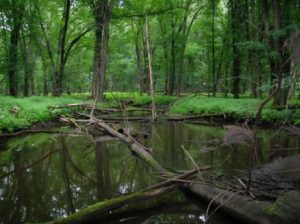This summer, our intern Sam Bower worked on many projects both in the field and at his desk. An avid swimmer, Sam got to experience a more wild side of our aquatic world by doing creekwalks to monitor water quality. Sam is studying at the University of Michigan for a degree in ecology, evolution, and biodiversity. His internship was supported by the Doris Duke Conservation Scholars Program.

As I immersed my senses in the beauty of the riverine environment—the bubbling water, chirping birds, the scents of plants wafting through the air—I didn’t notice my arms gently graze a stinging nettle. The underbrush was dense, but taking a brief terrestrial route out of the creek offered an easier alternative to crawling across a grove of fallen trees and weaving through hanging branches. The stinging nettles hid in the maze of green and brown surrounding me.
Suddenly, like tiny pinpricks set aflame, a sharp pain paired with little bumps spread across my forearms. They rapidly shot up my arms as the plants’ potent defenses made their presence known on my skin. Despite being hot, tired, and somewhat thirsty with sweat dripping into my eyes and my soaked collar plastered to my neck, I wasn’t mad. The stinging was the result of years of evolution in plant defense. Like the river, it represents the ebb and flow of natural systems on our planet. For a few moments, while I clenched my fists to forget the burning, I erupted into laughter. I laughed at the unexpectedness of it all. I laughed for the way the sun lit up the earth around me. I laughed because I thought of all the animals that tried eating this plant only to feel their mistake. To even be in a space where nature still thrives was invigorating.
Little moments like this remind me that despite being human, I am not invincible. I can handle a little burn here and there, especially considering I had just spent the past three hours stirring up the creek bed and traversing over terrestrial plants in an effort to assess river health. These small disturbances are nothing a strong storm isn’t incapable of, but over time and on much larger scales due to expanding human urbanization the effects are drastically magnified. Not only are terrestrial ecosystems affected by this expansion, but aquatic ecosystems are vulnerable to pollution, habitat degradation, and biodiversity loss.
I know the water, the bugs, even the stinging nettle, assemble into a thriving ecosystem teeming with life. After wading through the cool water, spending time with the plants that thrive at the water’s edge, climbing over fallen trees and listening for the sound of frogs hopping into the creek, I felt loved by this environment. I hope it felt loved by my companions and myself as we navigated this world to protect and restore the water resources in our community.



